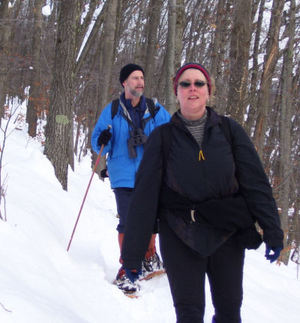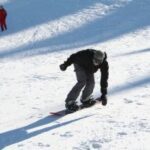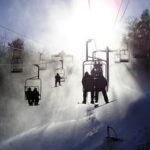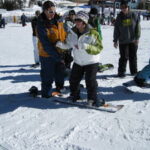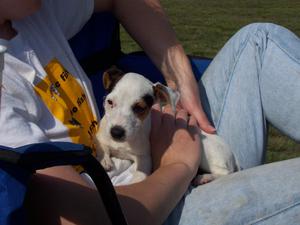If you can walk you can snowshoe (well, ok, you need snow). If you snowshoe you have the potential improve your fitness level and burn more calories than running or skiing!
Snowshoeing has become a common recreational winter activity in the past few years. Nearly anyone can do it, it’s relatively inexpensive, and doesn’t require travel to specialized areas (like ski slopes) to participate. You need a snowy trail, or just your back yard, or the neighborhood woods.
When you snowshoe, you can burn up to 45% more calories than walking or running at the same speed. Several factors contribute to this increase. First, exercising in cold weather increases your metabolic rate. Second, you are walking with added weight on your feet- providing the same effect as wearing ankle weights. And there is the added resistance of moving through snow.
The number of calories you burn snowshoeing will depend upon four factors: the terrain, the condition of the snow (packed or powder), your pace (and whether or not you use poles) and your body size. For example, if you are small, say 120 pounds, and you walk on packed snow and flat terrain for an hour you will burn about 360 calories. That’s quite a few, for just an hour of walking.
At the other end of the spectrum, if you are 180 pounds, and run on snowshoes on packed, flat snow for an hour you can burn over 1000 calories!
Walking with poles in powder snow on hilly terrain, can push that hour for the small person up to 670 calories, while the 180 pound person will again burn just over 1000 calories in that same scenario.
The American Hiking Society has provided the chart 2 shown in the image (click to enlarge to make it readable).
Self.com offers a calculator where you can enter your weight in either pounds or kilograms, the time you snowshoe, and then it will give you the number of calories burned. It does not take the snow condition, terrain, or your pace into consideration. The values it returns compare with the American Hiking Society chart in the range of walking on packed snow on terrain that is something slightly more than flat. It could be used as a minimum number of calories burned, and is quick and easy.
Snowshoeing is an aerobic exercise that uses major muscle groups. The intensity of the activity over an extended time improves cardiovascular fitness. All this, and yet it is a low-impact sport. Ray Browning, technical director of Tubbs Snowshoes says, “Snowshoeing is low impact due to the fact that snow is softer than asphalt or concrete and the construction of the snowshoe acts as a shock absorber for your feet, reducing the typical impact forces associated with running.” 1
I can personally testify that the winter I injured a knee skiing I was able to continue to snowshoe all winter without pain because the broad base of the snowshoe provided so much stability it felt more secure than even walking. The knee healed completely, and I didn’t have to give up winter exercise.
Why not get out of the gym and into the great outdoors this winter, and burn some extra calories too?
1. Quoted in American Hiker, December 2000, a publication of the American Hiking Society
2. American Hiker, “Pop Quiz,” December 2000, a publication of the American Hiking Society
